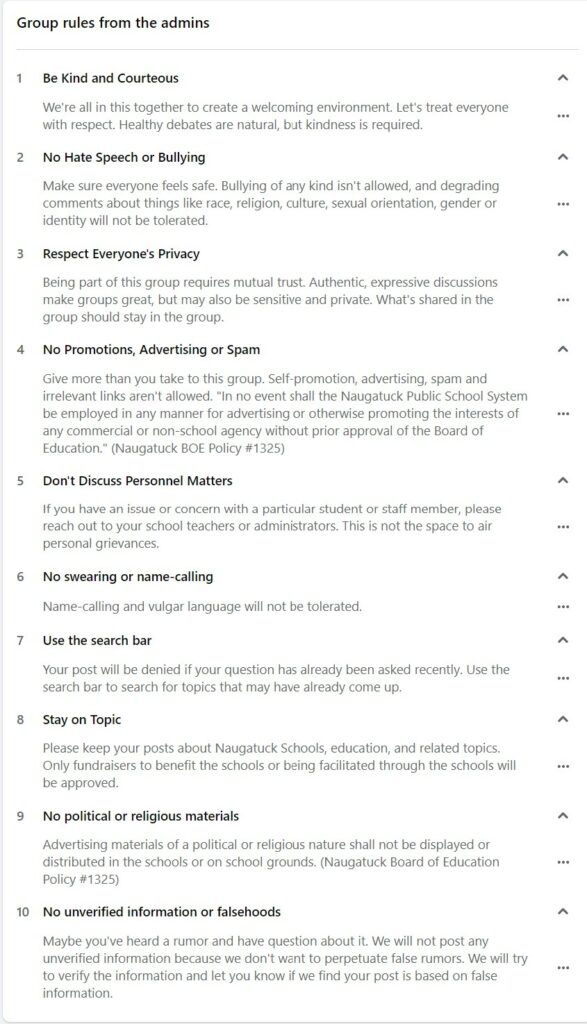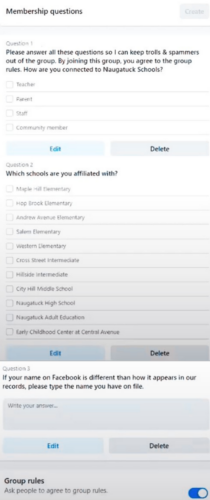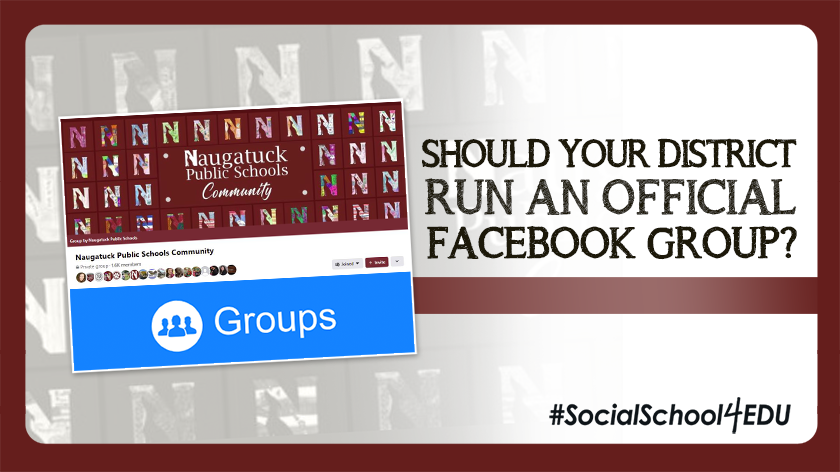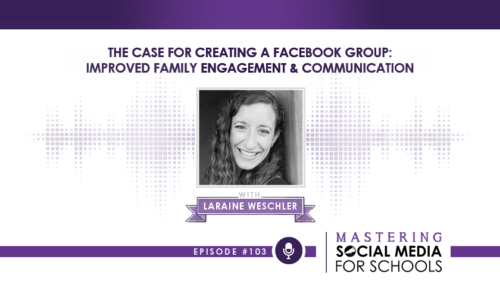Naugatuck Public Schools is a 5,000-student district located in Connecticut. During the height of the pandemic, when it shut its doors to in-person instruction alongside the majority of U.S. schools, its communications specialist made a bold decision: To start a district Facebook group.
Now we’ve written about Facebook groups on this blog before (see “How to Handle Community Gossip Groups on Social Media”) and the topic hasn’t always been positive! Facebook groups used to be the Wild West of the platform, rife with spam and uncontrolled conversations.
But Laraine Weschler, that bold communications specialist, moved forward with her plan to launch an official Facebook group for the district. Two years later, her efforts have paid off richly in building community engagement, improving communication, and even enhancing the district’s primary public page.
Out of the group’s 1,500 members, 1,300 are active in the group – an incredible 86% engagement rate that is nearly impossible to achieve with a Facebook page!
“Pump the brakes, Andrea! I already have too much on my plate!”
You have my full permission to NOT feel obligated to add “start and run a Facebook group” to your never-ending school communicator to-do list. But I hope you’ll at least consider the pros and cons of implementing this strategy for your district! Much of the work is done up front, in setting up the group and establishing parameters, and from there you can create systems to fit this into your school social media management schedule – as we’ll discuss, below.
This blog was inspired by Laraine Weschler, who recently led a stellar webinar inside of my Membership Program, all about how to effectively set-up and manage a thriving community Facebook group for her school. Laraine also made a guest appearance on the Mastering Social Media for Schools podcast, where we discussed her Facebook group strategy.
Pros and Cons of a District Facebook Group
I love having a forum where we can share information and ask questions related to the schools or things going on in Naugatuck to other parents. It’s a great platform for sharing information. I find it very helpful!” – Danielle, parent in the Naugatuck Public Schools’ Facebook group.
As you can see from this parent’s feedback, the NPS Facebook group is a safe space for sharing and discussing anything related to the school. That is one of the biggest “pros” for having an official group – it allows for back-and-forth, real time discussions among school constituents.
Unlike a Facebook page, a Facebook group can allow its members to create their own posts. This way, communication can go both ways, and the school now has a direct connection to its most engaged parents and community members. This helps build trust and transparency, and allows community members to feel heard and understood.
While the often-negative, free-wheeling community Facebook groups can be a thorn in your side, an official school group allows you to answer questions directly and limit the spread of misinformation. Let’s face it – every district faces controversies, big and small! Having your own group keeps any heated debates within a semi-private space. You can also keep an eye out for common questions or frustrations that are bubbling up, and address topics head-on – within the group, on your main page, and/or through other communications channels.
A group also allows you to provide reasoning and context behind school rules or decisions that are being discussed. And you can do so head-on, right at the source of the discussion!
As the group administrator, you don’t have to know everything. You can point people in the right direction to find information, such as a website link or asking them to call/email their child’s teacher or coach.
Your Facebook group can also be a great place to solicit feedback, ask for content submissions for your main page, and build relationships through engaging questions and polls.
Finally, as a group administrator, you have a LOT of control when it comes to who is in your group, if and how often they can post/comment, and the group rules. We’ll talk about all these features in the next section.
Of course, there are some drawbacks to starting an official Facebook group for your school…
It means you have one more channel to monitor, as a social media manager.
Another drawback is that in general, groups tend to draw more negative comments than pages, since people are in a more private space and feel like it’s a safe place to vent frustrations. Just remember that the vast majority of these people just want the best for their kids! Even if their opinions are wrong or misinformed, they are nearly always coming from a place of genuine concern.
Setting up a District Facebook Group
In Laraine’s webinar, she broke down all the nuts and bolts of setting up a group. Because Facebook wants to encourage people to join groups, it is constantly adding new tools and features for group administrators and moderators to use – so by the time you set up your group, you could have even more options available than what we’ve listed here
- Create your group on a computer. Go to the side panel of your Facebook page and click “Groups” and then “Create a New Group.”
- Choose a group name. Laraine’s is “Naugatuck Public Schools Community.”
- Choose the privacy setting. Laraine’s is set to “private” and “visible” so only members can see what’s being posted but anyone can find the group.
- Add a cover photo that includes your school logo and/or name.
- Under Settings, add a description that summarizes what the group is all about. Laraine’s is “This is a group where you can ask questions, share information, support one another, and connect parents, staff, and community members across Naugatuck Public Schools. Posts in this group do not necessarily reflect the views of the Naugatuck Public Schools. This is a community forum meant to provide a vehicle for all stakeholders to be heard.”
- Under Settings, customize the group URL so it’s easy to remember.
- Under Settings, customize the group’s colors. Facebook will suggest colors based on your cover photo.
- Under Settings, add your main district page under “group affiliation” so that it shows up on that Facebook page under the “Groups” tab. This makes it easier for people to find.
- Under Settings, select the option so that only people can join the group (not pages).
- Set-up your Admin Assist, which allows you to choose who will be approved to be in the group, whether or not posts need to be approved before they go live, and more. Laraine’s group is set-up to only allow people living within 25 miles of the school to join, and all posts must be approved by an administrator or moderator before they will go live.
- Set-up membership questions and group rules. These are critical! Laraine’s are listed below.
- Add other administrators/moderators – we recommend at least one other person, besides you.
- Publicize your group! Share it on the main Facebook page, link it on your school website, encourage your staff to join, put it in your school newsletter, etc.
Sample Group Rules

Sample Membership Questions

Managing a District Facebook Group
Once you have these parameters in place, your group is ready to start on the right foot. Before they even join, people will understand the expectations and the types of content they can expect to see (and post) within the group. They also know that by joining the group, they have an official line of communication to the district.
Laraine spends just 1-2 hours per week inside of her very active group. Much of the heavy lifting is done by other members! You’ll find that parents answer each other’s questions, and not every post is going to require your response.
When Laraine declines a post, it’s due to breaking a group rule or asking something that’s repetitive. She is also able to filter out any posts related to specific personnel issues, private businesses, or political content.
Laraine also posts fun questions (use this list of ideas!), polls, event announcements, and calls for content. For example, “Share your first day of school photos here! We may repost to the main Facebook page!” gets people involved and also gives you a wealth of content for your main page. All of these posts can be scheduled in advance – batch your work to save your sanity!
Other Ways to Use a Facebook Group for Your District
If you allow teachers and coaches to create social media pages for their micro-audiences, consider having them run groups, instead. These are more private and tailored to their exact audiences.
You could also use a Facebook group for internal staff communications!
One final note about running a Facebook page AND a Facebook group for your district…
These are complementary efforts. One shouldn’t take away from the other. Your main school page is still the primary place to celebrate your students and staff with the world, while your group is aimed at answering questions and generating discussion among your district’s direct constituents. Posts from BOTH your page and your group will show up in the newsfeed of your followers/members – they aren’t competing with each other!
So What Now?
Ok, now you have the full story. Let me know: Will you be adding a Facebook group to help facilitate communication in your community? Or maybe you already have one and can share some lessons learned? I’d love to hear about it. Leave me a comment below!



